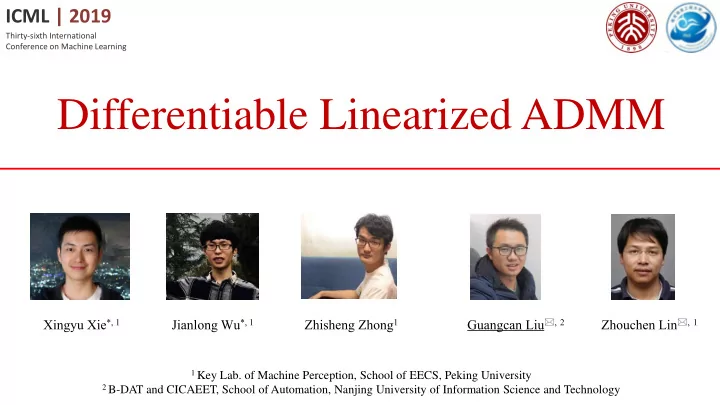

ICML | 2019 Thirty-sixth International Conference on Machine Learning Differentiable Linearized ADMM Guangcan Liu , 2 Zhouchen Lin , 1 Xingyu Xie *, 1 Jianlong Wu *, 1 Zhisheng Zhong 1 1 Key Lab. of Machine Perception, School of EECS, Peking University 2 B-DAT and CICAEET, School of Automation, Nanjing University of Information Science and Technology
Background Optimization plays a very important role in learning • Most machine learning problems are, in the end, optimization problems SVM K-Means min 𝑔 𝑦, data , 𝑡. 𝑢. 𝑦 ∈ Θ … 𝑦 Deep Learning --- personal opinions: In general, what the computers can do is nothing more than “computation”. Thus, to assign them the ability to “learn”, it is often desirable to convert a “learning” problem into some kind of computational problem. Question: Conversely, can optimization benefit from learning ?
Learning-based Optimization A traditional optimization algorithm is indeed an ultra-deep network with fixed parameters min 𝑔 𝑦, data , 𝑡. 𝑢. 𝑦 ∈ Θ 𝑦 𝑢+1 = (𝑦 𝑢 ) 𝑦 2 +𝜇 ∥ 𝑦 ∥ 1 min ∥ 𝑧 − 𝐵𝑦 ∥ 2 𝑦 𝑦 𝑢+1 = ℎ 𝜄 𝑋 𝑓 𝑧 + 𝑇𝑦 𝑢 𝑇 = 𝐽 − 𝐵 𝑈 𝐵 𝑓 = 𝐵 𝑈 𝜍 , 𝑋 𝜍 Learning-based optimization: Introduce learnable parameters and “reduce” the network depth, so as to improve computational efficiency • Gregor K, Lecun Y. Learning fast approximations of sparse coding. ICML 2010. • P. Sprechmann, A. M. Bronstein, and G. Sapiro Learning, Efficient Sparse and Low Rank Models , TPAMI 2015 • Yan Yang, Jian Sun, Huibin Li, Zongben Xu. ADMM-Net: A deep learning approach for compressive sensing MRI, NeurIPS 2016. • Brandon Amos, J. Zico Kolter. OptNet: optimization method as a layer in neural network. ICML 2017.
Learning-based Optimization ( Con’t ) Limits of existing work • In a theoretical point of view, it is unclear why learning can improve computational efficiency, as theoretical convergence analysis is extremely rare X. Chen, J. Liu, Z. Wang, W. Yin, Theoretical linear convergence of unfolded ISTA and its practical weights and thresholds, NeurIPS, 2018. specific to unconstrained problems
D-LADMM: Differentiable Linearized ADMM Target constrained problem: known convex LADMM (Lin et al, NeurIPS 2011) : D-LADMM: are learnable non-linear functions learnable param.:
D-LADMM ( Con’t ) Questions: Q1: Can D-LADMM guarantee to solve correctly the optimization problem? Q2: What are the benefits of D-LADMM? Q3: How to train the model of D-LADMM?
Main Assumption assumption required by assumption required by LADMM: D-LADMM: generalized none-emptiness of Assumption 1
Theoretical Result I Q1: Can D-LADMM guarantee to solve correctly the optimization problem? A1: Yes! D- LADMM’s k -th layer output distance to the solution set solution set of original problem Theorem 1 and Theorem 2 [ Convergence and Monotonicity ] (informal).
Theoretical Result II Q2: What are the benefits of D-LADMM? A2: Converge faster! D-LADMM > LADMM Theorem 3 [ Convergence Rate ] (informal). If the original problem satisfies Error Bound Condition (condition on A and B ), then linear convergence General case (no EBC): Lemma 4.4 [ Faster Convergence ] (informal). Define operators: For any 𝜕 ,
Training Approaches Q3: How to train the model of D-LADMM? Unsupervised way: minimizing duality gap where is the dual function. Global optimum is attained whenever the objective (duality gap) reaches zero! Supervised way: minimizing square loss ground-truth 𝑎 ∗ and 𝐹 ∗ are provided along with the training samples
Experiments Target optimization problem Table 1. PSNR comparison on 12 images with noise rate 10%. 15-layer D-LADMM achieves a performance comparable to, or even slightly better than, the LADMM algorithm with 1500 iterations!
Conclusion Convergence: D-LADMM layer- wisely converges to the desired Theory solution set D-LADMM LADMM Speed: D-LADMM converges to the solution set faster than LADMM does Empiricism minimizing duality gap minimizing square loss (unsupervised) (supervised)
Recommend
More recommend